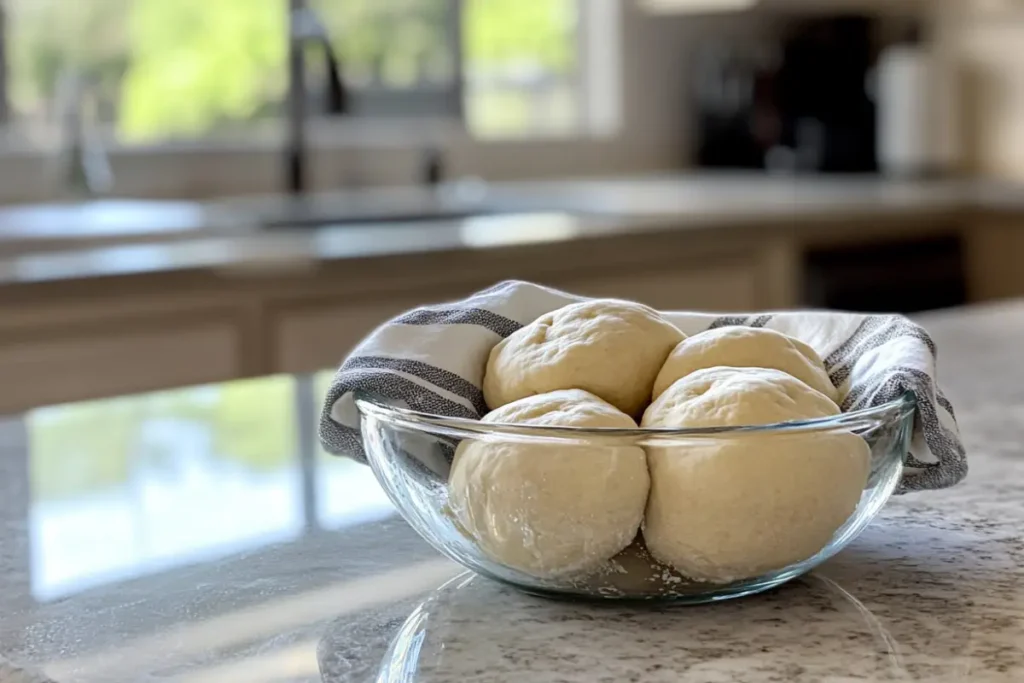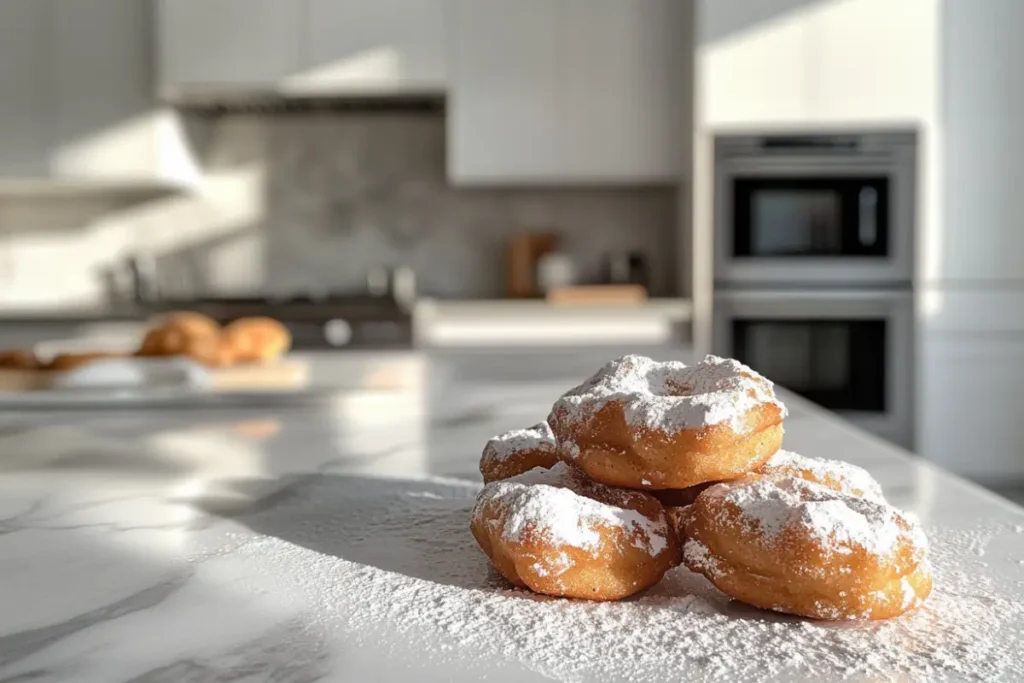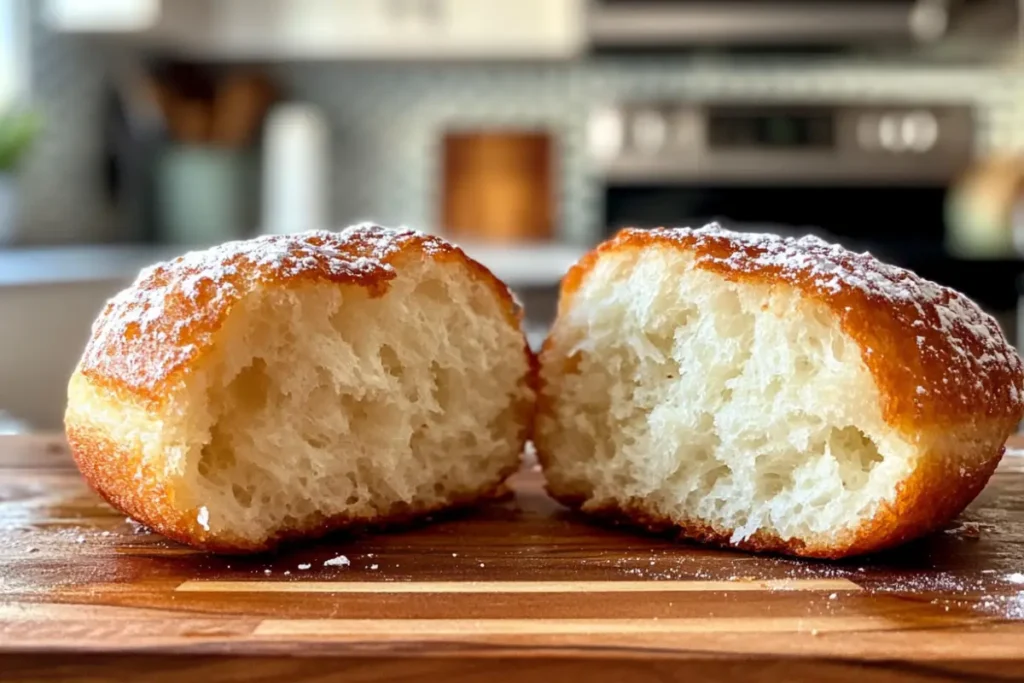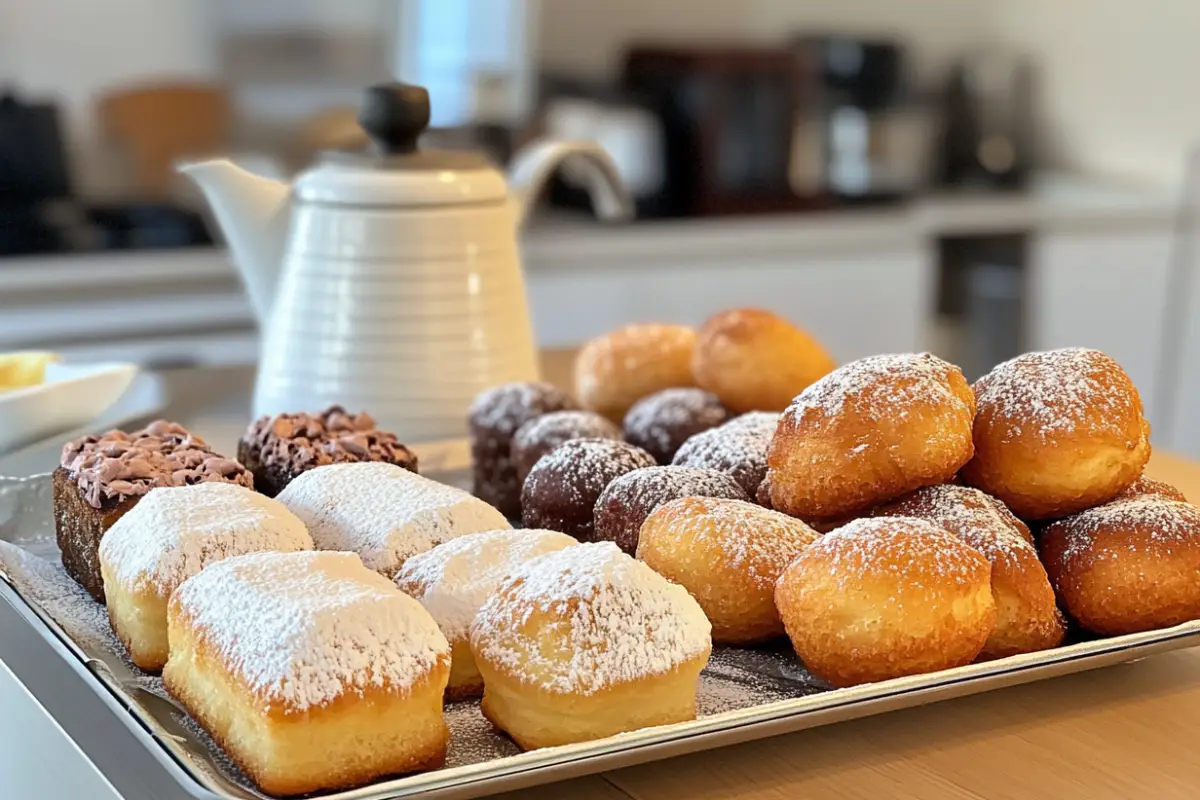Last Updated on March 7, 2025 by Simon
There’s something undeniably magical about biting into a freshly made beignet, the crispy, golden exterior giving way to an airy, pillowy center, all dusted with a generous layer of powdered sugar. But what’s the secret to making beignets that are perfectly light and fluffy, just like those served at iconic cafés in New Orleans? These beloved fried pastries may seem simple, but achieving the right texture and flavor takes more than just following a recipe.
But here’s the thing: making perfect beignets at home can be tricky. Many people try to replicate the authentic café-style beignets and end up with dense, greasy dough, flat pastries, or an uneven texture. So, what is the secret to making beignets that are just as light, fluffy, and irresistible as those you find in New Orleans? The answer lies in understanding the science behind the dough, the perfect frying technique, and the importance of the right ingredients.
In this article, we’ll reveal the key secrets to making perfect beignets, discuss common pitfalls, and share proven tips to help you achieve that melt-in-your-mouth texture. Whether you’re a seasoned baker or a beginner, mastering these tips will elevate your beignets to café-level perfection.
Table of contents
The Secrets to Beignet Success
The truth is, there’s no single secret to making perfect beignets rather, it’s a combination of several factors that work together to create the ultimate pastry. In fact, understanding the key techniques is essential because it will help you avoid common mistakes and, as a result, ensure your beignets turn out light, airy, and golden every time. Therefore, paying attention to each step will make all the difference in achieving that perfect café-style treat.
Let’s break down the top secrets to making beignets and why each one matters.
1. The Dough: It’s All About Yeast and Hydration

The most critical part of making beignets is getting the dough right. Traditional beignet dough is a type of yeasted dough, similar to brioche. The yeast is what gives beignets their signature airy texture.
Here’s why the dough matters so much:
- Yeast activation: Ensuring that the yeast is properly activated is key. If the yeast doesn’t activate correctly, your beignets will be dense and flat.
- Hydration levels: The dough needs to have the perfect balance of wet and dry ingredients. Too much moisture, and your beignets will be soggy inside. Too little, and they’ll be dry and heavy.
Pro Tip: To ensure your dough rises perfectly, let it proof in a warm, draft-free environment for at least 1-2 hours. This gives the yeast time to work its magic.
2. The Right Ingredients: Freshness Is Key
When it comes to making the perfect beignet, the quality of your ingredients matters.
- Fresh yeast or active dry yeast: Old yeast will result in a flat dough that won’t rise properly.
- High-quality flour: Choose a flour with a higher protein content to ensure structure and fluffiness.
- Powdered sugar: Don’t skimp on the powdered sugar topping! It’s an essential part of the beignet experience.
3. Temperature Control: The Perfect Frying Oil Temperature
One of the biggest mistakes people make when frying beignets is not paying attention to the oil temperature. The ideal frying temperature is between 360°F and 375°F (182°C to 190°C).
Why is this important?
- Too low: The beignets will absorb too much oil, making them greasy and heavy.
- Too high: The outside will burn before the inside is fully cooked.
Pro Tip: Use a candy thermometer to keep a close eye on your oil temperature. If you don’t have one, test the oil by dropping a small piece of dough in it, it should sizzle immediately and start to float.
4. The Rolling and Cutting Technique: Precision Matters
Getting the right shape and thickness is another crucial step.
- Roll the dough to about 1/4 inch thick: Too thick, and they won’t cook evenly. Too thin, and they’ll be crispy instead of fluffy.
- Cut the dough into squares or rectangles: Traditional beignets are square-shaped, about 2 to 3 inches across.
Pro Tip: Use a pizza cutter or sharp knife for clean, even cuts.
5. Frying Time: Don’t Overcrowd the Pan
When it’s time to fry, resist the urge to add too many beignets to the oil at once.
Why?
- Overcrowding lowers the oil temperature, which can make your beignets greasy.
- Fry in small batches to maintain the right temperature and ensure each beignet has room to puff up.
6. The Secret Ingredient: A Dash of Nutmeg or Vanilla
Here’s a lesser-known secret: adding a small amount of nutmeg or vanilla extract to the dough enhances the flavor and gives your beignets that authentic taste.
Pro Tip: Add ½ teaspoon of nutmeg or 1 teaspoon of vanilla extract to your dough for a subtle flavor boost.
7. The Final Secret to Making Beignets: Letting Them Rest Before Frying
Many home cooks skip this step, but letting the dough rest after rolling and cutting is crucial. Resting allows the dough to relax and helps the beignets puff up beautifully when fried.
Pro Tip: After cutting the dough, let the pieces rest for 10-15 minutes before frying.
Pro Tips for Success: Master the Art of Perfect Beignets
Achieving café-style beignets at home takes more than just following a recipe. To get that light, airy texture and golden-brown exterior, you need to pay attention to the little details that make a big difference.
Here are some pro tips to help you master the process and troubleshoot any issues along the way.
1. Pay Attention to the Yeast
The yeast is the heart of your beignet dough, and if it doesn’t activate properly, you’ll end up with flat, dense pastries.
Tip #1: Always check the expiration date on your yeast.
Using expired yeast is a common mistake. If you’re unsure whether your yeast is still active, test it by dissolving it in warm water with a pinch of sugar. If it bubbles within 5-10 minutes, it’s good to use.
Tip #2: Use warm water, not hot.
Yeast thrives in temperatures around 105°F to 110°F (40°C to 43°C). Water that’s too hot will kill the yeast, while cold water won’t activate it properly.
2. Knead the Dough Properly
Proper kneading develops gluten, which gives beignets their structure and elasticity.
Tip #1: Knead until the dough is smooth and elastic.
You’ll know the dough is ready when it’s no longer sticky and holds its shape when stretched.
Tip #2: Use the windowpane test.
To check if your dough is kneaded enough, stretch a small piece of dough between your fingers. If it forms a thin, translucent “window” without tearing, you’ve got the perfect dough.
3. Don’t Rush the Proofing Process
Proofing is the process of letting the dough rise, allowing the yeast to work its magic and create air bubbles.
Tip #1: Let the dough rise until it doubles in size.
Depending on your room temperature, this can take anywhere from 1 to 2 hours. Be patient, rushing this step will result in dense beignets.
Tip #2: Proof the dough in a warm, draft-free area.
If your kitchen is cold, place the dough in an oven with the light on or near a warm appliance to speed up the process.
4. Use the Right Frying Oil (first secret to making beignets to know)
The type of oil you use for frying will affect the taste and texture of your beignets.
Tip #1: Choose a neutral oil with a high smoke point.
The best oils for frying beignets are vegetable oil, canola oil, or peanut oil. These oils have a high smoke point and won’t overpower the flavor of your beignets.
Tip #2: Strain and reuse your oil.
After frying, let the oil cool, strain out any leftover bits, and store it for your next batch of beignets.
5. Fry in Small Batches
Overcrowding the fryer is a common mistake that leads to soggy, greasy beignets.
Tip: Fry 4-5 beignets at a time.
This ensures the oil temperature stays consistent and that each beignet has room to puff up and cook evenly.
6. Dust with Powdered Sugar Generously
Beignets aren’t complete without a thick coating of powdered sugar.
Tip: Use a fine-mesh sieve or sifter to dust the sugar evenly.
For a true Café du Monde experience, don’t hold back on the powdered sugar!
7. Serve Beignets Fresh
Beignets are best when they’re freshly fried and still warm.
Tip: Serve immediately after frying.
The texture and flavor are at their best when beignets are enjoyed fresh. If you must store them, reheat them in a warm oven (about 300°F/150°C) to revive their fluffiness.
8. Avoid Overhandling the Dough
Beignets should be light and airy, not dense and chewy.
Tip: Handle the dough gently after the first rise.
Avoid pressing out too much air when rolling and cutting the dough. The air bubbles created during proofing are what give beignets their fluffy texture.
Variants of Beignets and the Secret to Perfecting Each One

While the classic New Orleans-style beignet is perhaps the most famous, there are many delicious variants of beignets around the world. Each version has its own unique twist, whether it’s the ingredients, shape, or cooking method. In this section, we’ll explore popular beignet variants and uncover the secret to mastering each one.
1. New Orleans-Style Beignets (Classic Café Beignets)
Origin: New Orleans, Louisiana, USA
Secret: Yeast-risen dough + high frying temperature
These are undoubtedly the most famous beignets, traditionally served at the iconic Café du Monde in New Orleans. Typically, they are square-shaped, yeast-leavened doughnuts that are fried to golden perfection and then heavily dusted with powdered sugar. As a result, they have a delightfully light, fluffy interior and a slightly crispy exterior that makes them irresistible.
The Secret to Making these Beignets:
- Perfect yeast activation is key to creating that airy texture.
- The dough should be slightly sticky to retain moisture, ensuring the beignets puff up when fried.
- Oil temperature must be maintained between 360°F and 375°F (182°C to 190°C) for the perfect golden-brown crust.
Pro Tip: Use bread flour for better gluten development, which helps create the signature chewy-yet-airy texture.
2. French Beignets (Beignets de Carnaval)
Origin: France
Secret: Choux pastry dough
In France, beignets are often made using pâte à choux (choux pastry) instead of a yeast dough. This is the same dough used to make cream puffs and éclairs. French beignets are lighter and more delicate than their New Orleans counterparts.
The Secret:
- Master the choux pastry technique. The dough should be smooth and pipeable, with the right balance of moisture to puff up in the oil.
- Add eggs gradually when making the dough to achieve the perfect consistency.
- Fry at medium-high heat (around 350°F/175°C) to ensure they puff up without burning.
Pro Tip: Dust with cinnamon sugar or fill with jam or Nutella for a modern twist.
3. Italian Zeppole
Origin: Italy
Secret: Ricotta cheese in the dough
Zeppole are Italian-style beignets made with a soft dough that often includes ricotta cheese for added moisture and richness. They can be sweet or savory and are often served during St. Joseph’s Day celebrations.
The Secret to Making these Beignets:
- Incorporate ricotta cheese to create a rich, moist dough.
- Don’t overmix the dough. Overmixing can make the zeppole tough.
- Fry at a slightly lower temperature (around 340°F/170°C) to allow the inside to cook through without burning the outside.
Pro Tip: Sprinkle with powdered sugar or dip them in honey or chocolate sauce for a decadent treat.
4. Spanish Buñuelos
Origin: Spain and Latin America
Secret: Anise or citrus flavor
Buñuelos are a type of beignet popular in Spain, Mexico, and other Latin American countries. They can be round or flat and are often flavored with anise seed, lemon, or orange zest.
The Secret:
- Flavor the dough with anise or citrus zest to give it a distinctive taste.
- Roll the dough thin for a crispy texture or keep it thicker for a fluffy center.
- Fry at medium heat to get a crisp exterior without overcooking the inside.
Pro Tip: Serve with a drizzle of syrup or a sprinkle of cinnamon sugar for a traditional touch.
5. Dutch Oliebollen
Origin: The Netherlands
Secret: Dried fruits in the dough
Oliebollen are Dutch-style beignets traditionally enjoyed on New Year’s Eve. The dough is typically made with raisins, currants, or other dried fruits and is shaped into round balls before frying.
The Secret:
- Soak the dried fruits before adding them to the dough to prevent them from drawing moisture from the batter.
- Use a thicker dough to help the oliebollen hold their shape when fried.
- Fry at medium-high heat (around 350°F/175°C) to ensure they’re cooked through without being greasy.
Pro Tip: Dust with powdered sugar before serving and pair with a hot beverage.
6. Louisiana Calas (Sweet Rice Beignets)
Origin: Louisiana, USA
Secret: Leftover rice in the dough
Calas are a Creole variant of beignets made with leftover cooked rice mixed into the dough. They are slightly denser than traditional beignets and have a unique texture and flavor.
The Secret to Making these Beignets:
- Use day-old rice to prevent the dough from becoming too wet.
- The rice should be mashed or blended into the dough for a smoother texture.
- Fry at medium-high heat to achieve a crispy exterior and soft interior.
Pro Tip: Serve with molasses or cane syrup for an authentic Louisiana experience.
7. West African Puff-Puff
Origin: West Africa
Secret: Simple ingredients + deep frying
Puff-puff is a popular West African street food that’s similar to beignets. It’s made with a simple batter of flour, sugar, yeast, and water, and it’s often flavored with nutmeg or vanilla.
The Secret:
- Use a very wet dough to achieve a light, airy texture.
- Let the dough rise twice for the best results.
- Fry at medium heat to ensure the puff-puff cooks evenly without burning.
Pro Tip: Serve with spicy pepper sauce or sprinkle with powdered sugar for a sweet version.
8. Beignets de Banane (Banana Beignets)
Origin: Caribbean and Africa
Secret: Mashed bananas in the batter
Banana beignets are a highly popular dessert in the Caribbean and various parts of Africa. Typically, they’re made by adding mashed bananas directly to the batter, which, in turn, gives them a naturally sweet, fruity flavor. As a result, this unique ingredient adds both moisture and richness, making these beignets stand out from more traditional versions.
The Secret:
- Use ripe bananas for maximum sweetness and moisture.
- Adjust the flour quantity to balance the extra moisture from the bananas.
- Fry at medium heat to caramelize the bananas without burning the dough.
Pro Tip: Dust with coconut flakes or serve with a drizzle of rum sauce for a tropical twist.
Mastering the secrets to perfect beignets is ultimately all about getting the details right, from a well-proofed dough to the ideal frying temperature. In fact, paying attention to these small but essential steps can make a huge difference in your final results. With the tips and techniques shared here, you’ll quickly be on your way to creating light, fluffy beignets that easily rival those served at iconic cafés.

If you’re inspired to try more variations, don’t miss our guide on How to Make Authentic French Jelly Beignets at Home for a delicious twist on this classic treat. And if you’re aiming to perfect the New Orleans-style version, be sure to check out The Secret to Homemade Beignets That Rival New Orleans for even more tips.
With a little practice and patience, you’ll be serving up café-worthy beignets in no time. Happy frying!

